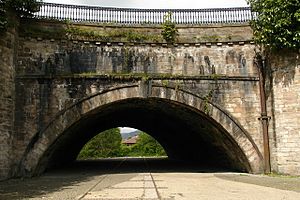Luggie Aqueduct facts for kids
Quick facts for kids Luggie Aqueduct |
|
|---|---|
 |
|
| Carries | Forth & Clyde Canal |
| Crosses | Luggie Water |
| Heritage status | Category A listed |
The Luggie Aqueduct is a special kind of bridge that carries the Forth and Clyde Canal over the Luggie Water river. You can find it near Kirkintilloch, which is north of Glasgow in Scotland. This amazing structure is so important that it's listed as a Category A listed building, meaning it's a very important historical building.
Contents
Building the Aqueduct: A Look Back
Who Built the Luggie Aqueduct?
The Luggie Aqueduct was built by a famous engineer named John Smeaton. He worked on it for the Forth and Clyde Canal between 1768 and 1775. Imagine how much effort it took to build something like this so long ago!
Why Was It Built?
Canals are like man-made rivers that help boats travel across land. The Forth and Clyde Canal needed a way to cross the Luggie Water river without stopping. So, engineers designed the Luggie Aqueduct to lift the canal high above the river below. This allowed boats to keep moving smoothly on their journey.
How the Aqueduct Was Designed
Size and Structure
The Luggie Aqueduct is about 37.8 meters (124 feet) long. It has one main arch that stretches 13.7 meters (45 feet) wide. The canal on top is quite wide, about 27.4 meters (90 feet), which means two boats can easily pass each other without any trouble.
A Bridge for Boats and Trains
In 1848, something interesting happened! A railway line called the Campsie Branch was built. This railway actually passed through the arch of the aqueduct, above the Luggie Water river. It was carried on a special twin-arch culvert, which is like a tunnel for water, so the river could flow underneath the train tracks.
Imagine a boat sailing over a train, and the train going over a river! It was a very clever design.
What's There Now?
The railway tracks are no longer there. Today, you can find a footpath where the trains used to run. You can even still see the marks of the old railway lines on the ground. The aqueduct and the bridge below it are made from strong, grey stone called ashlar. The sides of the aqueduct have a gentle arch, sloping about 1 in 10, similar to another famous structure called the Kelvin Aqueduct.

